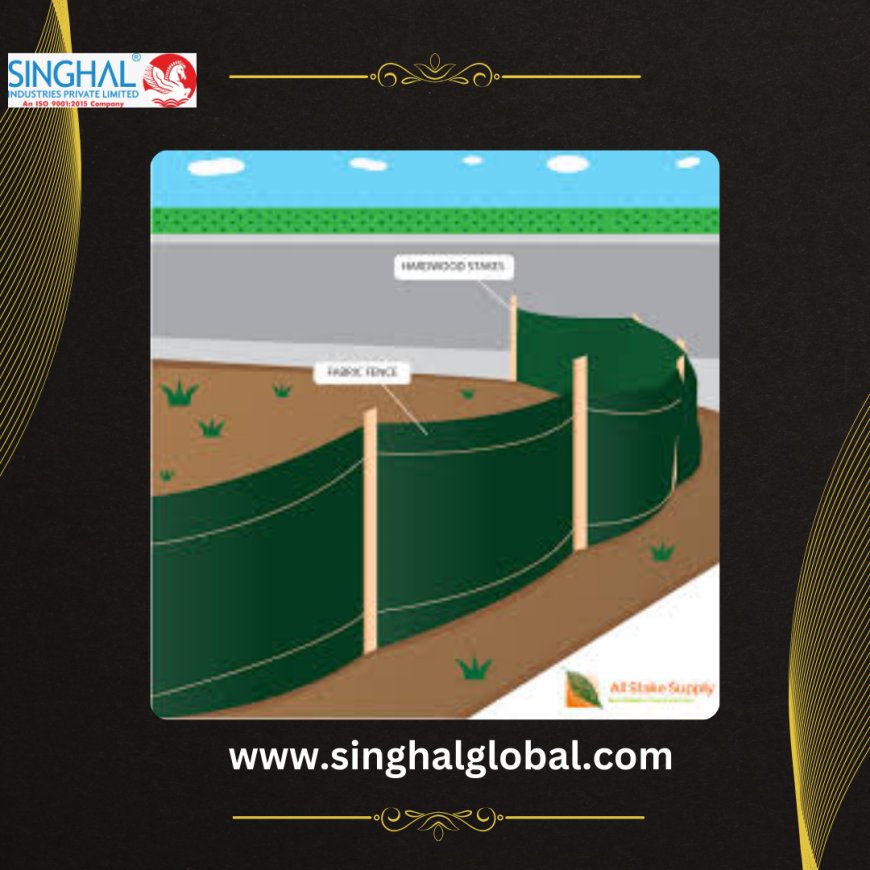Protecting Water Quality: The Role of Silt Fences in Erosion Prevention
A silt fence is a temporary sediment control barrier made of geotextile fabric supported by wooden or metal posts. It is designed to prevent sediment from entering water bodies during construction or land disturbance activities by allowing water to flow through while trapping sediment.

Silt fences are temporary sediment control devices used primarily during construction and land disturbance activities. Their main purpose is to protect water quality by preventing sediment from entering nearby water bodies. Erosion can significantly impact water quality, leading to increased turbidity, nutrient loading, and harmful algae blooms. Therefore, the use of silt fences is critical in maintaining the ecological balance in our water systems.
How Silt Fences Work
Silt fences consist of a geotextile fabric stretched across wooden or metal posts. When water flows towards the fence, the fabric slows down the water velocity, allowing sediment to settle behind it. This process effectively traps sediment, preventing it from being carried away by stormwater runoff. Understanding the mechanics of silt fences is essential for any silt fence manufacturer, as the design and installation must ensure maximum effectiveness in various environmental conditions.
Types of Silt Fences Available
Silt fences come in various types and specifications, catering to different project requirements. A reliable Silt fence manufacturer offers options such as standard silt fences, reinforced silt fences, and biodegradable silt fences. Each type is designed for specific applications, with varying durability and lifespan. For instance, reinforced silt fences are often used in high-erosion areas due to their enhanced strength, while biodegradable options are suitable for environmentally conscious projects.
The Role of Silt Fences in Erosion Control
Silt fences play a crucial role in controlling erosion on construction sites and other disturbed lands. Without proper sediment control measures, erosion can lead to significant environmental degradation. Soil erosion not only depletes the topsoil but also contributes to the sedimentation of rivers, lakes, and streams, adversely affecting aquatic life. The implementation of silt fences significantly mitigates these risks, showcasing their importance as a tool for silt fence manufacturers and environmental engineers alike.
Environmental Regulations and Silt Fences
With the increasing awareness of environmental issues, many regions have established regulations regarding sediment control during construction activities. Silt fences are often mandated by local and federal regulations to prevent sediment from contaminating water bodies. Compliance with these regulations is crucial for construction companies, making partnerships with reputable silt fence manufacturers essential. These manufacturers provide quality products that meet regulatory standards, ensuring projects adhere to environmental guidelines.
Selecting the Right Silt Fence Manufacturer
Choosing the right silt fence manufacturer is vital for ensuring the effectiveness of erosion control measures. Factors to consider include the quality of materials used, the reputation of the manufacturer, and their compliance with industry standards. A reliable manufacturer will provide silt fences that are durable, easy to install, and effective in preventing sediment runoff. Furthermore, consulting with Silt fence exporters can help in sourcing high-quality products from different regions, providing a broader selection for construction projects.
Installation Best Practices for Silt Fences
Proper installation of silt fences is crucial for their effectiveness. A silt fence must be installed at the right angle, depth, and height to maximize sediment trapping. The fabric should be entrenched into the ground to prevent water from flowing underneath, and the posts must be securely anchored. Following the manufacturer's installation guidelines will ensure optimal performance, allowing the fence to withstand heavy rainfall and high water flows. Training construction personnel on these best practices is vital for the successful implementation of silt fences.
Maintenance of Silt Fences
Regular maintenance of silt fences is essential to ensure their continued effectiveness. Sediment buildup behind the fence can reduce its ability to trap additional sediment, leading to potential failures. Routine inspections should be conducted to assess the condition of the fence, looking for tears, sagging, or sediment overflow. Silt fence manufacturers typically provide maintenance guidelines, which should be followed to keep the fencing in optimal condition throughout the project duration.
Silt Fences and Sustainable Construction
Silt fences are an integral part of sustainable construction practices. As the construction industry increasingly focuses on sustainability, implementing effective erosion control measures like silt fences becomes essential. By preventing sediment from entering water bodies, these fences help protect aquatic ecosystems and maintain water quality. Using silt fences in combination with other sediment control measures, such as sediment basins and vegetative buffers, can create a comprehensive erosion control plan that aligns with sustainable construction principles.
The Future of Silt Fences in Erosion Prevention
As environmental awareness grows, the demand for effective erosion control measures continues to rise. The role of silt fences will remain significant in construction and land development, particularly in sensitive areas near water bodies. Advances in materials and technology may lead to the development of even more effective silt fences, providing greater durability and performance. Silt fence manufacturers are likely to innovate further to meet the evolving needs of the industry while adhering to environmental regulations.
Case Studies: Successful Implementation of Silt Fences
Numerous case studies highlight the successful implementation of silt fences in various projects. For example, a construction site near a river implemented silt fences as part of their erosion control plan. The silt fences effectively reduced sedimentation in the river, leading to improved water quality and healthier aquatic life. Such success stories underline the importance of silt fences and the need for collaboration between construction companies and silt fence manufacturers to achieve optimal results.
The Role of Silt Fence Exporters in Global Markets
Silt fence exporters play a crucial role in making quality erosion control products available to international markets. By sourcing high-quality silt fences from reputable manufacturers, exporters can meet the demand for effective sediment control solutions worldwide. This global reach allows construction projects in various regions to benefit from reliable silt fence solutions, contributing to improved water quality and environmental protection on a larger scale.
Conclusion: The Importance of Silt Fences in Protecting Water Quality
In conclusion, silt fences are vital tools in protecting water quality and preventing erosion in various settings. Their ability to trap sediment and comply with environmental regulations makes them indispensable in construction and land development. By partnering with reputable Silt fence manufacturer and exporters, construction companies can ensure they are using the best products available for effective erosion control. The continued emphasis on sustainability and environmental protection will further enhance the role of silt fences in safeguarding our water resources for future generations.
Frequently Asked Questions (FAQs)
1: Who are the leading silt fence manufacturers?
Answer: There are several reputable silt fence manufacturers globally, providing high-quality products to meet regulatory standards. It’s essential to research and choose manufacturers known for their reliability and compliance with environmental regulations.
2: How do silt fences help protect water quality?
Answer: Silt fences help protect water quality by preventing sediment from entering water bodies, which can lead to issues such as increased turbidity, nutrient loading, and harm to aquatic ecosystems. By trapping sediment, silt fences contribute to maintaining the ecological balance in affected areas.
3: What regulations apply to the use of silt fences?
Answer: Regulations regarding the use of silt fences can vary by location. Many regions have specific guidelines for sediment control during construction, often requiring the installation of silt fences to minimize environmental impact. It's crucial to consult local regulations to ensure compliance.
What's Your Reaction?





















